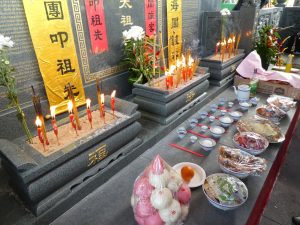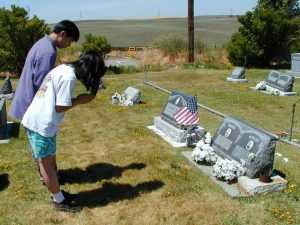…. the story of two families.

Jeanne Young reminded me this year Ching Ming is April 4, 2020. Here is the story she graciously shared of how Ching Ming is celebrated by her family …
“I’m not sure if our BACGG members participate in Ching Ming, but I have been visiting our family cemetery twice a year for as long as I can remember. Most folks visit the cemetery at least once a year for Ching Ming (Spring time). This is the one day families pay respect to their departed relatives.
First we clean the grave sites and headstones, then we display flowers and a food offering. Lastly we burn candles, incense and paper offerings to our ancestors. It is normal to see several thousand people converge at the cemetery on a specific date to honor their ancestors.
Ching Ming is very important to us, especially, since both my parents have passed. We now have a much better understanding of why we had been going to the cemetery since we were children. As a child, I did not know whose grave we were visiting, but today, I visit dozens of grave sites two times a year.
If you have Rosemary Gong’s book “Good Luck Life”, she wrote a very informative chapter about Qing Ming (Ching Ming).
Not all Chinese families follow the same practices. They may be customized to fit each families memories. Some families have forgotten this ritual, especially as descendants move far away from where their ancestors are buried.
Due to the Coronavirus, my family association made a wise decision not to host an official Ching Ming festival this year. However individual families and individuals can still visit the cemetery on their own to pay respect to their relatives, which is what I am planning to do.”

Ron Chan’s Ching Ming Remembrances … When my mom, May, visits her parents at the cemetery, she brings two thermos, one with hot coffee with cream and sugar for her mother, and hot tea for her father. May pours a cup for each of them. Then kneels and then gently serves them tea over their final resting place … just as May did in life. Ron’s kids then bow three times to honor their great grandparents.
Even though Ching Ming has been observed for thousands of years, my mother said, “No need to visit me when I am gone, as you loved me when I was alive.”

Please share how you honor those that came before you on Ching Ming in the comments section below ….

I started getting all my five younger brothers and their families to go to the cemetery for Qing Ming several years ago. Although we no longer have a picnic like we did when I was a kid, we do visit the burial sites of our parents and grandfather. (I still recall my father lighting a cigarette or two to stick in the ground of one of our relatives!) A few years ago, under pouring rain, I read a letter I had written to each parent, acknowledging how much they contributed to who I am today. Last year, with our children and grandchildren in tow, I asked each member to recall what we appreciated about our mother. Our children and wives expressed their own gratitude, thus not limiting the participation to only the brothers. This endeavor allowed each member to contribute something. You would be surprised what ensues because we all share different memories and the exercise engenders tighter bonds in the family. With over 30 people, this can take some time, so we only managed to cover only our mother with the thought that we would do this for our father this year. I do believe, though, that it is a worthy tradition to carry on and certainly much more meaningful than to merely bring flowers to a grave site. Afterwards, we head to a dim sum restaurant for further renewal.
Thank you for sharing this Frank. They say a person dies twice. Once when he takes his last breath. The second is when he is forgotten. You are keeping the memory of your parents and grandparents well into the next generation. Good job.
“They” are the Mexican people who observe Dia de los Muertos, so their traditions are close to Chinese ones.
According to David Lei, the animated film —— made more money in China than in the U.S. so Pixar asked him to
accompany a scouting group up to Marysville to do some “recky” aka reconnaisance as the Brits would say,
to check out possible locations and story lines for a Chinese version of ——. My senior brain can see the film in
my head but can’t bring up the name.
I grew up going to the cemeteries in Colma to only offer flowers, as my family swore off incense after my grandfather started a small fire one particularly hot and dry year (a wonderful family story after the fact, lol!) But marrying into my husband’s family was also marrying into tradition — his family visits no fewer than four cemeteries and dozens of graves belonging to immediate and extended family members and even some close family friends. They visit both in the spring for Ching Ming, doing more extensive offerings of food and incense at this time as it’s the larger of the two festivals, and also in the fall for Chung Yeung. Up to 15-16 of us will travel together from grave to grave. Different families are assigned to bring various items: flowers, fruit, dim sum, incense, paper money. I’ve come to understand it as a special, almost sacred, time not just for paying respects to the deceased but also to get the family together and to give space to tell family stories. Setting up at each grave takes time, as does burning incense and paper money, and this time is used for storytelling. Usually they’re the same family stories, over and over, but for the younger generations (my husband’s now high school age cousins, and now our kids), this repetition is what will help them internalize the story. I love that my kids will know family lore as mundane as how Great-Grandma took her coffee from McDonald’s to the story of the child bride married in the afterlife to a distant relative.
My husband and my mother-in-law went to the Chinese Cemetery (Luk Shan) in Daly City last weekend to leave flowers. They reported back that it was very empty, at a time when we would normally be jostling for parking spaces. It was so empty, in fact, that they saw a coyote hanging out in the cemetery (!) (Ron, I can send you a photo of this as proof! :))
Marisa,
Thanks for sharing your family rituals to the cemetery. I need to find out how to locate the great grandfather’s plot and my parent’s plots in the Chinese cemetery to pay our respects. Where is the Chinese cemetery’s office located and their phone number in SF Chinatown? Us six siblings haven’t been there since we were young adults. Thanks again for all your expertise.
Hi Suzanne: You’re welcome! I’d love to refer your question about cemetery offices to David Lei. Let’s reach out to David and see if he can comment here about how to contact the various cemetery offices and what information you need (English/Chinese names? Dates of death?) in order to successfully receive an answer from them. I’m curious to know as well.
Per David: During non-pandemic/shelter in place times, the office of Luk Shan Cemetery (run by the Chinese Cemetery Association) is open at 34 Jason Court in San Francisco Chinatown. Their phone number is (415) 982-4148. He recommends calling ahead to find out their open hours.